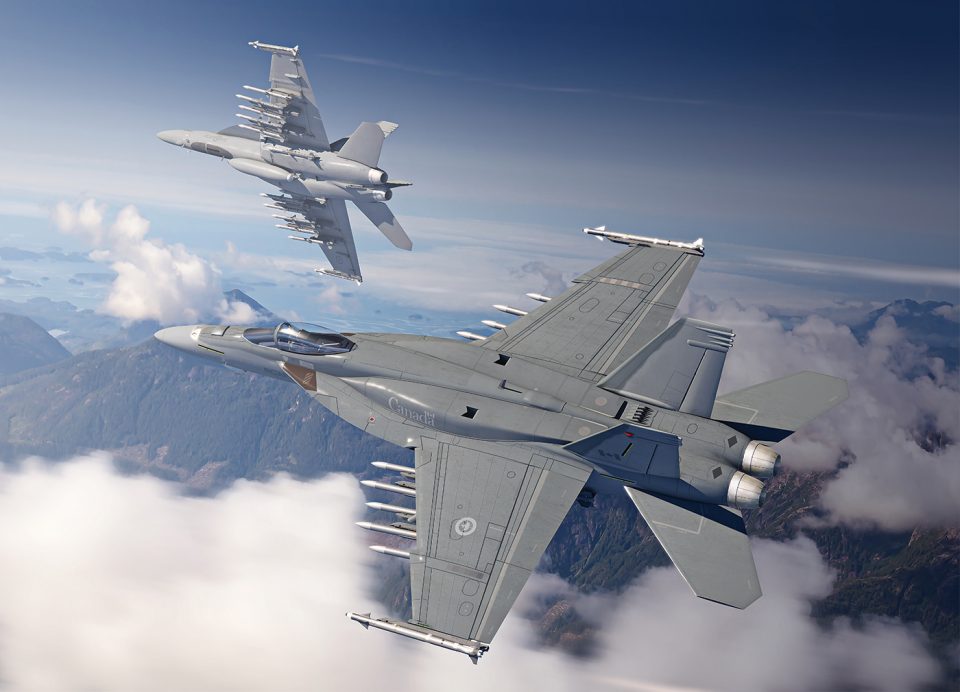Choosing the F/A-18E/F Super Hornet Block III to replace Canada’s aging fighter jet fleet will generate $61 billion and nearly 250,000 jobs for the Canadian economy over the 40-year life of program, according to a report by an Ottawa consulting firm.
“It means the productivity of each job is going to be around $246,000 per worker. That is very good . . . they are high-productivity jobs,” said Rick Clayton, economist at Doyletech Corp.

The astounding numbers were unveiled in a media briefing on Oct. 27 as Boeing laid out some details of its value proposition to the Canadian government and new partnership agreements with a team of Canadian companies that will sustain the aircraft if selected.
Charles “Duff” Sullivan, managing director of Boeing Canada and a former CF-188 Hornet pilot, said the consulting firm’s projections were “based on real data and direct contributions to Canada and our economy,” and are numbers the company “can guarantee to Canada.”
Boeing was one of three aircraft manufacturers to submit a bid on July 31 for 88 fighter jets to replace the Royal Canadian Air Force’s fleet of legacy CF-188 Hornets. Lockheed Martin’s F-35A Lightning II and Saab’s Gripen E are also in the running.
With up to 20 per cent of the evaluation process weighted on how well the companies meet the government’s Industrial and Technological Benefits (ITB) policy, Boeing has been keen to demonstrate the level and range of its investments across Canada.
In a similar presentation in June, Doyletech asserted that Boeing directly invested $2.3 billion in Canada in 2019, primarily through its aerospace composite manufacturing operation in Winnipeg, and generated about 11,000 jobs. Once indirect spending was factored in, those figures climbed to around $5.3 billion and 20,000 jobs.
“Those are good results,” said Clayton, noting that Boeing’s total spend in Canada has increased from approximately $1 billion to $2.3 billion annually over the last 10 years, procuring from a wide-ranging supply chain of small and medium businesses. “We have identified from our research more than 500 different suppliers.”
He emphasized that Boeing fits the definition of an “agile producer” that “maximizes local skills, industrial clusters, and supplies and inputs that are available from the local area.” Moreover, Boeing and its partners all export most of their Canadian production.

Clayton suggested all levels of government and all regions stand to benefit from the Super Hornet Block III program. Municipal governments could see as much as $994.1 million in revenue over the life of the program, while provincial and federal governments could gain $6,761.5 million and $8,487.9 million, respectively.
Over the past 25 years, Boeing has fulfilled over $11 billion in ITB obligations for programs ranging from the legacy CF-188 and an upgrade project, to the CC-177 Globemaster II, the CH-147F Chinook and the ScanEagle unmanned aerial system. Clayton called Boeing’s approach “economically efficient.”
He noted the company and its partners have large investments in every region of Canada and are “key players” in aerospace industrial clusters, which often generate high productivity indirect jobs. “It means [there are] opportunities to do vertical and horizontal linkages with Canadian suppliers and thereby multiple things.”
In particular, he flagged Boeing’s investments and direct participation in industry-university networks, centres of excellence, and even a learning factory incorporating big data, machine learning and artificial intelligence. “In fact, we think that Boeing’s commitment to innovation alone has a benefit of almost $4 billion. It is one of the most important parts of the Boeing proposition.”
Jennifer Seidman, Boeing’s lead for international strategic partnerships in Canada, confirmed the company’s commitment to “deliver 100 per cent” of its ITB obligations. She noted that Boeing’s offer “exceeds the minimum requirements for in-country support in training, maintenance support – both aircraft and engines – weapons systems management and engineering, and information and material management.”
As part of Boeing’s previous ITB commitments, she highlighted several recent investments in Canadian companies, including a cash investment and engineering support in Bluedrop Training & Simulation to develop a full size, high fidelity and immersive virtual reality ramp trainer for the V-22 Osprey. As well as investments in Heroux-Devtek for the main landing gear for the F-18 Hornet program, and nose and main landing gear for the F-15 Eagle program.
Boeing has said previously it will sustain the Super Hornet using a model developed to support the CH-147F Chinook program at 450 Tactical Helicopter Squadron in Petawawa, Ont. The benefits of that “tip-to-tail” model became evident during the Chinook’s 12-month aeromedical evacuation mission on Operation Presence in Mali in 2018-19, said Mario Clement, who leads Boeing’s sustainment program in Canada.

That program relies on support from several partners, some of whom will help sustain the Block III Super Hornet. As part of the media briefing, Boeing announced five new agreements with CAE, L3Harris Technologies, Peraton Canada, Raytheon Canada and GE Canada Aviation that will ensure training solutions; sustainment services; avionics repair and overhaul; supply chain and warehousing services; and maintenance, repair and overhaul support services for the F414 engines, respectively.
Boeing evaluated the merits of building the Super Hornet in Canada, but saw little long-term benefit with a relatively small production run of 88 aircraft, said Jim Barnes, director of business development in Canada for Boeing Defense, Space & Security. “It didn’t make business sense to us, so our offering is concentrating on decades and decades of lifecycle.”
Final assembly will occur in St. Louis, Mo., and the intellectual property and knowledge of the Block III will be transferred to its partners following a “build-in” approach similar to the legacy fleet, where more is shared “as our Canadian partners accept more and more work on the platform.”


